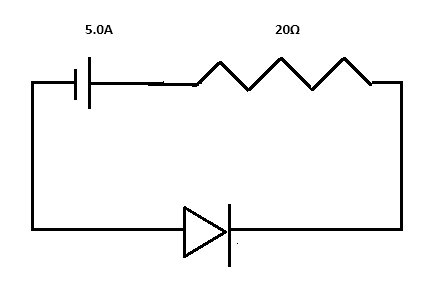
Calculate current through the circuit and potential difference across the circuit in the given figure. The drift current of the diode is \[20\mu\]A.
Answer
217.2k+ views
Hint: The current flowing through the diode and resistor are equal. The potential difference can be calculated by using ohm’s law. If the current flows in a closed circuit in the form of an electrical charge then the potential difference does not move or flow it is applied.
Complete step by step solution:
As evident from the above diagram, the diode and the resistor are in series. Therefore, the amount of current flowing through is equal to the drift current.
Given the drift current is\[20\mu A\].
Therefore, the current through the circuit is also\[20\mu A\].
Converting \[\mu A\] TO A, \[20\mu A = 20 \times {10^{ - 6}}\]
Employing ohm’s law to find the potential drop across the resistor.
Now, we know ohm’s law states that the current through the conductor between two pots is directly proportional to the voltage across the two points, given parameters like temperature, pressure being constant.
Therefore, we can say, voltage is proportional to the current flowing, let R be the resistor of the circuit and also the constant of proportionality.
\[V = IR\]
Where:
\[V = \] Potential Difference across two points
\[I = \] Current flowing through the points
\[R = \]Resistor of the circuit
Putting the values, in the above equation, WE GET:
\[V = 20 \times {10^{ - 6}} \times 20\]
Therefore, solving the equation, we obtain:
\[V = 0.4mV\]
The total voltage applied through the battery is \[5.0V\].
Therefore, the potential difference, across the diode, is total voltage applied to the circuit (via battery) minus the potential difference across the resistor:
\[V = (5.0 - 0.4 \times {10^{ - 3}})V\]
Thus, we obtain,
\[V = 4.9996V\]
Thus, is the required answer is:
Current through the circuit is: \[20\mu A\]
Potential Difference, across the resistor is: \[4.9996V\].
Note: Drift current is defined as the current caused by particles being pulled by an electric field. All units must be converted to their SI units, otherwise it may give an erroneous result. The potential difference is only expressed in Volt.
Complete step by step solution:
As evident from the above diagram, the diode and the resistor are in series. Therefore, the amount of current flowing through is equal to the drift current.
Given the drift current is\[20\mu A\].
Therefore, the current through the circuit is also\[20\mu A\].
Converting \[\mu A\] TO A, \[20\mu A = 20 \times {10^{ - 6}}\]
Employing ohm’s law to find the potential drop across the resistor.
Now, we know ohm’s law states that the current through the conductor between two pots is directly proportional to the voltage across the two points, given parameters like temperature, pressure being constant.
Therefore, we can say, voltage is proportional to the current flowing, let R be the resistor of the circuit and also the constant of proportionality.
\[V = IR\]
Where:
\[V = \] Potential Difference across two points
\[I = \] Current flowing through the points
\[R = \]Resistor of the circuit
Putting the values, in the above equation, WE GET:
\[V = 20 \times {10^{ - 6}} \times 20\]
Therefore, solving the equation, we obtain:
\[V = 0.4mV\]
The total voltage applied through the battery is \[5.0V\].
Therefore, the potential difference, across the diode, is total voltage applied to the circuit (via battery) minus the potential difference across the resistor:
\[V = (5.0 - 0.4 \times {10^{ - 3}})V\]
Thus, we obtain,
\[V = 4.9996V\]
Thus, is the required answer is:
Current through the circuit is: \[20\mu A\]
Potential Difference, across the resistor is: \[4.9996V\].
Note: Drift current is defined as the current caused by particles being pulled by an electric field. All units must be converted to their SI units, otherwise it may give an erroneous result. The potential difference is only expressed in Volt.
Recently Updated Pages
Wheatstone Bridge Explained: Working, Formula & Uses

Young’s Double Slit Experiment Derivation Explained

JEE Atomic Structure and Chemical Bonding important Concepts and Tips

JEE Amino Acids and Peptides Important Concepts and Tips for Exam Preparation

Electricity and Magnetism Explained: Key Concepts & Applications

Chemical Properties of Hydrogen - Important Concepts for JEE Exam Preparation

Trending doubts
JEE Main 2026: Application Form Open, Exam Dates, Syllabus, Eligibility & Question Papers

Derivation of Equation of Trajectory Explained for Students

Hybridisation in Chemistry – Concept, Types & Applications

Understanding the Angle of Deviation in a Prism

Understanding Collisions: Types and Examples for Students

How to Convert a Galvanometer into an Ammeter or Voltmeter

Other Pages
JEE Advanced Marks vs Ranks 2025: Understanding Category-wise Qualifying Marks and Previous Year Cut-offs

Understanding Atomic Structure for Beginners

Ideal and Non-Ideal Solutions Explained for Class 12 Chemistry

Degree of Dissociation: Meaning, Formula, Calculation & Uses

Understanding Electromagnetic Waves and Their Importance

Understanding the Electric Field of a Uniformly Charged Ring




